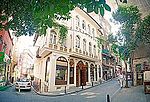2022 Istanbul bombing

The 2022 Istanbul bombing occurred on İstiklal Avenue in the Beyoğlu district of Istanbul, Turkey, on 13 November 2022 (2022-11-13), killing six people and injuring 81 others. The bombing is regarded as a terrorist attack. The city experienced previous terrorist attacks during the late 20th and early 21st century by Kurdish separatists and Islamist insurgents. An Islamic State suicide bombing in the same district killed four people in 2016.No group has claimed responsibility, but Turkish authorities announced that Kurdish separatists were behind the attack, implicating the Kurdistan Workers' Party (PKK) and the Syrian Kurdish Syrian Democratic Forces (SDF). Turkey's interior minister, Süleyman Soylu, announced the arrest of the bomber and forty-six others.PKK, and SDF denied involvements in the bombing, denounced it, and offered their condoleances. On 20 November, Turkey launched Operation Claw-Sword, bombing nearly 500 targets in Syria and Iraq. Top SDF officials called for resuming peace talks, avoid a deadly conflict, and vowed resistance if attacked.
Excerpt from the Wikipedia article 2022 Istanbul bombing (License: CC BY-SA 3.0, Authors, Images).2022 Istanbul bombing
Independence Avenue,
Geographical coordinates (GPS) Address Nearby Places Show on map
Geographical coordinates (GPS)
| Latitude | Longitude |
|---|---|
| N 41.035 ° | E 28.981388888889 ° |
Address
Ali Muhiddin Haci Bekir
Independence Avenue
34433 (Katip Mustafa Çelebi Mahallesi)
Turkey
Open on Google Maps







